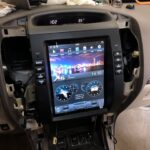For car enthusiasts and DIY mechanics, understanding your vehicle’s health is paramount. Enter the Bluetooth OBD2 programmer, a powerful tool that, when paired with the right app, can turn your smartphone into a sophisticated diagnostic center. Let’s dive into how a Bluetooth OBD2 scanner, like the Veepeak Mini, works with apps such as Torque Pro to give you in-depth insights into your car’s performance.
One popular and effective combination is the Veepeak Mini Bluetooth OBD2 Scanner used in conjunction with the Torque Pro app on Android. This setup allows you to access a wealth of information from your car’s computer, going beyond basic check engine light diagnostics. For Ford vehicle owners, Torque Pro offers even deeper customization. You can download specific Ford PIDs (Parameter IDs) to monitor parameters like FICM voltage and HPOP, offering a comprehensive view of your engine’s operation. These custom PIDs are usually available for free through online communities and forums, making it an accessible upgrade. Setting them up within Torque Pro involves navigating to settings and adding predefined PIDs, a process generally well-documented online.
The Pros of Using a Bluetooth OBD2 Programmer like Veepeak Mini with Torque Pro:
- Functionality: It simply works, providing reliable data and connection.
- Customizable Displays: You can tailor the dashboard to show the information most relevant to you.
- Extensive Customization: Torque Pro offers a wide array of settings and options for advanced users.
- Ford Specific PIDs: Access to custom Ford PIDs unlocks deeper diagnostics for Ford vehicles.
- Add-ons and Graphing: Expand functionality with various add-ons, including tools for graphing and data logging.
- Popular and Updated: Veepeak Mini and Torque Pro are widely used and frequently updated, ensuring compatibility and ongoing support.
- Universal and Compact: The Bluetooth dongle is small, discreet, and compatible with most OBD2 vehicles.
- Code Reading and Clearing: Diagnose and clear check engine lights and other diagnostic trouble codes.
The Cons to Consider:
- Overwhelming Customization: The sheer number of options can be daunting for beginners.
- Learning Curve: While quick to set up for basic use, mastering advanced features and customization takes time.
- Background Operation: Torque Pro runs in the background and requires manual quitting to fully close, which might be unexpected for some users.
- Power Drain: The Bluetooth dongle draws a small amount of power even when the car is off, although the drain is minimal.
- Graphing and Logging Complexity: Setting up advanced features like graphing and data logging can be intricate and sometimes frustrating.
- Update Frequency: Data updates are frequent but not as instantaneous as a direct laptop connection, which might be relevant for very precise real-time monitoring.
Comparison with Dedicated Tuners:
While Bluetooth OBD2 programmers excel at diagnostics and monitoring, dedicated tuners like SCT offer always-on displays and sometimes more streamlined interfaces for specific parameters. For instance, an SCT tuner can constantly display temperatures like oil, coolant, transmission, and exhaust gas. However, for in-depth diagnostics when issues arise, a Bluetooth OBD2 programmer provides a more versatile and detailed toolkit. You can configure dashboards in Torque Pro to display similar temperature readings and much more, offering a broader range of diagnostic capabilities.
In Conclusion:
For DIY car maintenance and diagnostics, a Bluetooth OBD2 programmer paired with an app like Torque Pro is an invaluable tool. The Veepeak Mini offers a reliable and affordable hardware solution, while Torque Pro provides a feature-rich software platform. While there’s a learning curve to fully utilize its potential, the depth of information and customization available makes this combination a powerful asset for understanding and maintaining your vehicle’s health. Whether you’re diagnosing a check engine light or monitoring your engine’s performance, a Bluetooth OBD2 programmer empowers you with data-driven insights, right at your fingertips.
